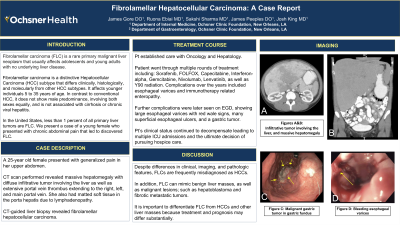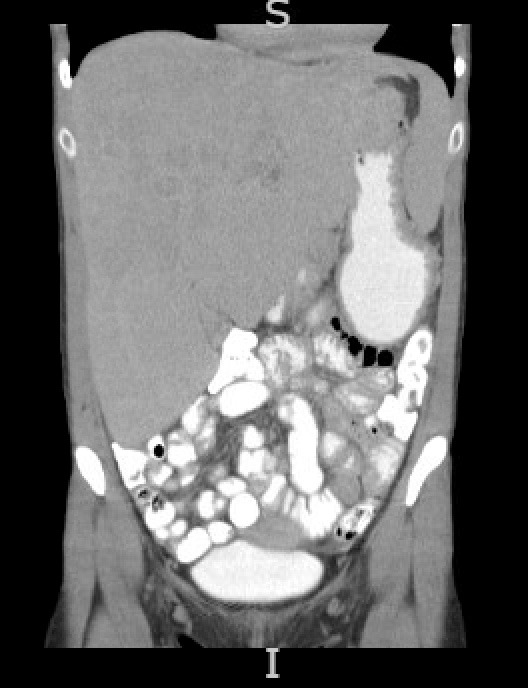Sunday Poster Session
Category: Liver
P1296 - Fibrolamellar Hepatocellular Carcinoma: A Case Report
Sunday, October 27, 2024
3:30 PM - 7:00 PM ET
Location: Exhibit Hall E

Has Audio

James Gore, DO
Ochsner Health Clinic Foundation
New Orleans, LA
Presenting Author(s)
James Gore, DO, Ruona Ebiai, MD, Sakshi Sharma, MD, James Peeples, DO, Josh King, MD
Ochsner Health Clinic Foundation, New Orleans, LA
Introduction: Fibrolamellar carcinoma (FLC) is a rare primary malignant liver neoplasm that usually affects adolescents and young adults with no underlying liver disease. Fibrolamellar carcinoma is a distinctive Hepatocellular Carcinoma (HCC) subtype that differs clinically, histologically, and molecularly from other HCC subtypes. It affects younger individuals 5 to 35 years of age. In contrast to conventional HCC, it does not show male predominance, involving both sexes equally, and is not associated with cirrhosis or chronic viral hepatitis. In the United States, less than 1 percent of all primary liver tumors are FLC. We present a case of a young female who presented with chronic abdominal pain that led to discovered FLC.
Case Description/Methods: A 25 year old female who presented with generalized pain in her upper abdomen. CT scan performed soon after revealed massive hepatomegaly with diffuse infiltrative tumor involving the liver as well as extensive portal vein thrombus extending to the right, left, and main portal vein. She also had matted soft tissue in the porta hepatis due to lymphadenopathy. CT-guided liver biopsy revealed fibrolamellar hepatocellular carcinoma.
Initiation of multiple rounds of chemotherapy and Y90; associated with esophageal varices, gastric tumor, and immunotherapy related enteropathy. Further complications were later seen on EGD, showing large esophageal varices with red wale signs, many superficial esophageal ulcers, and large fungating mass along the lesser curvature of the gastric body. Pt’s clinical status continued to decompensate leading to the decision of pursuing hospice care.
Discussion: Despite differences in clinical, imaging, and pathologic features, FLCs are frequently misdiagnosed as HCCs. In addition, FLC can mimic benign liver masses, as well as malignant lesions; such as hepatoblastoma and fibrotic metastatic tumors. It is important to differentiate FLC from HCCs and other liver masses because treatment and prognosis may differ substantially.

Disclosures:
James Gore, DO, Ruona Ebiai, MD, Sakshi Sharma, MD, James Peeples, DO, Josh King, MD. P1296 - Fibrolamellar Hepatocellular Carcinoma: A Case Report, ACG 2024 Annual Scientific Meeting Abstracts. Philadelphia, PA: American College of Gastroenterology.
Ochsner Health Clinic Foundation, New Orleans, LA
Introduction: Fibrolamellar carcinoma (FLC) is a rare primary malignant liver neoplasm that usually affects adolescents and young adults with no underlying liver disease. Fibrolamellar carcinoma is a distinctive Hepatocellular Carcinoma (HCC) subtype that differs clinically, histologically, and molecularly from other HCC subtypes. It affects younger individuals 5 to 35 years of age. In contrast to conventional HCC, it does not show male predominance, involving both sexes equally, and is not associated with cirrhosis or chronic viral hepatitis. In the United States, less than 1 percent of all primary liver tumors are FLC. We present a case of a young female who presented with chronic abdominal pain that led to discovered FLC.
Case Description/Methods: A 25 year old female who presented with generalized pain in her upper abdomen. CT scan performed soon after revealed massive hepatomegaly with diffuse infiltrative tumor involving the liver as well as extensive portal vein thrombus extending to the right, left, and main portal vein. She also had matted soft tissue in the porta hepatis due to lymphadenopathy. CT-guided liver biopsy revealed fibrolamellar hepatocellular carcinoma.
Initiation of multiple rounds of chemotherapy and Y90; associated with esophageal varices, gastric tumor, and immunotherapy related enteropathy. Further complications were later seen on EGD, showing large esophageal varices with red wale signs, many superficial esophageal ulcers, and large fungating mass along the lesser curvature of the gastric body. Pt’s clinical status continued to decompensate leading to the decision of pursuing hospice care.
Discussion: Despite differences in clinical, imaging, and pathologic features, FLCs are frequently misdiagnosed as HCCs. In addition, FLC can mimic benign liver masses, as well as malignant lesions; such as hepatoblastoma and fibrotic metastatic tumors. It is important to differentiate FLC from HCCs and other liver masses because treatment and prognosis may differ substantially.

Figure: Infiltrative tumor involving the liver and massive hepatosplenomegaly.
Disclosures:
James Gore indicated no relevant financial relationships.
Ruona Ebiai indicated no relevant financial relationships.
Sakshi Sharma indicated no relevant financial relationships.
James Peeples indicated no relevant financial relationships.
Josh King indicated no relevant financial relationships.
James Gore, DO, Ruona Ebiai, MD, Sakshi Sharma, MD, James Peeples, DO, Josh King, MD. P1296 - Fibrolamellar Hepatocellular Carcinoma: A Case Report, ACG 2024 Annual Scientific Meeting Abstracts. Philadelphia, PA: American College of Gastroenterology.
